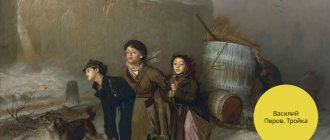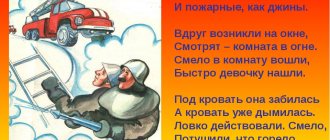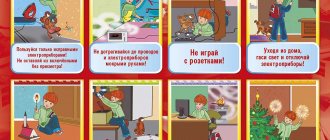Reverse counting
Counting down is counting to 10 and back, that is, in descending order: 10, 9, 8, 7, 6, 5, 4, 3, 2, 1, 0. Counting down is necessary for all preschoolers to master, since counting down is the necessary minimum knowledge for successful study in 1st grade. The easiest way to start teaching to count backwards is through objects, that is, through visual-figurative thinking, which helps preschool children to assimilate new information received much better. teaching a child to count backwards only after forward counting has been well mastered and put into practice, otherwise the child will get confused and will not learn new knowledge.
Count to 20
As a rule, counting to 10 for children 3 years old is not difficult. Things are a little different when it comes time to learn to count within 20. Difficulties can arise when counting to 10 is not entirely clear for children, which means that parents, in their desire to teach the baby to count, rushed and thereby confused him. You need to ask the question of how to teach a child to count to 20 only when he knows the numbers well, counting within 10.
When studying counting within 20 with children, they need to explain and confirm the main nuances, for example:
- The number consists of 2 digits. The first is tens, the second is units. Counting material will help children master counting.
- Without knowing how to teach a child to count to twenty, you should give him a clear example of what this number can look like.
The best way to demonstrate this for preschoolers is to place two tanks in front of them. Put 2 items in one of them, ten in the second. Using this example, the child will be able to understand what tens are and what units are. - It is also necessary to explain that after 10 there are two-digit numbers, and their units follow each other (1,2,3 and so on).
- After the baby has learned the first 20 numbers, you can figure out how to teach your child to count in his head. To do this, you can consider examples based on available items. We teach the child to count to 20 by asking him to put a certain amount of prepared material (sweets, bagels, pebbles) into a container. In this case, the first time the task should be performed out loud, and the second time the counting of objects should be pronounced in the mind.
How to teach a child to count quickly in his head? It’s a matter of time, and only regular classes and improvement of acquired knowledge will become a prerequisite for mastering the count up to 100, and at the age of 5 this is quite possible. In addition, this is the right age to explain to a preschooler how to do it correctly.
Counting down
With the help of a poem about counting backwards and using toys and objects in a playful way, you can introduce your child to counting backwards from an early age, but after he has mastered counting forward.
There is a plate on the stump, with ten plums lying on it. The squirrel approached the plate and ran away with the plum.
Nine ripe plums in a plate, a mole ran up to the plate, he boldly extended his paw and put the plum in his mouth.
Eight plums on a clean dish. Someone kindly collected them. The nightingale, with a cheerful whistle, pecked the sweet plum.
There are seven wonderful plums on the stump in a blue plate. A flock of lovely butterflies took one with them.
Six left - very few! Hurry forest people! Then a magpie galloped up and took a berry with its beak.
There were exactly five ripe berries. A toothy wolf came running, started counting the berries, and took another one.
Here are four plums. You can’t pass by the smell! Fragrant and beautiful, I took one prickly hedgehog.
There are only three drains left. Who wants to treat themselves to the Sweet Bone inside? A tit took one away!
There is two cream on the plate. Who's reaching for the plate? Let's give one to the owl, and one will remain!
Counting to 10 and back
Tasks for counting down to 10 and back:
- Say the numbers from 3 to 1 in reverse order. Count down answer: 3 2 1.
- Say the numbers from 5 to 2 in reverse order. Count back answer: 5 4 3 2.
- Say the numbers from 7 to 3 in reverse order. Count back answer: 7 6 5 4 3.
- Say the numbers from 6 to 2 in reverse order. Count back answer: 6 5 4 3 2.
- Say the numbers from 8 to 1 in reverse order. Count down answer: 8 7 6 5 4 3 2 1.
- Say the numbers from 9 to 5 in reverse order. Count back answer: 9 8 7 6 5.
- Say the numbers from 10 to 6 in reverse order. Count back answer: 10 9 8 7 6.
- Say the numbers from 10 to 1 in reverse order. Count down answer: 10 9 8 7 6 5 4 3 2 1.
Thus, by completing various counting tasks you can easily test and consolidate your child’s knowledge of counting .
Learning to add and subtract: techniques
Once your little family member has mastered the ability to count objects in his head and immediately, then it’s time to master skills such as addition and subtraction.
Counting with a ruler
One of the easiest ways to learn, but not the most effective for the future. Learning to count with a ruler is quite easy, but it will be a little more difficult to move on to more advanced methods of calculation.
In order to teach children to count with a ruler, it is necessary to explain the following:
- To add two numbers, for example, “3” and “6”, you need to find the number “3” on the ruler and count 6 units (centimeters) to the right. The number the baby will arrive at is “9”. So 3+6=9.
- With subtraction, everything is similar to addition, only you need to move not to the right, but to the left side of the ruler. So, if you need to subtract 3 from 6, then we move to the left by 3 units and get to the number 3.
Subject account
The simplest and most popular way. You need to take the number of objects within which you need to learn to count. Let's say it's 10 apples.
To add 4+2 you need to ask to put two apples aside from the pile. Then add 4 more. Now you need to count the number of apples in a separate group - there will be 6. With subtraction, everything is the same: ask the little one to remove 3 apples from the resulting pile and count the remainder - there will be 3.
Maria Montessori Method
This technique is mastered through the child’s independent learning. All that is needed from an adult is an environment for learning, that is, to provide the necessary objects, using which children themselves will learn mathematics. These items were selected and invented by Montessori herself in the process of developing her methodology.
This method allows you to awaken the mathematical spirit and arouse interest in counting.
Methodology of Sergei Polyakov
To teach this technique, parents will need boxes and cubes. Initially, their number will not exceed 5, but over time it will increase up to one hundred. You also need to print numbers from one to the number of cubes on the pieces of paper.
The idea is simple: take two cubes and sheets of paper with the numbers “1” and “2”. One cube is placed in front of the participant and next to it a piece of paper with a unit, explaining that this is one cube. Immediately after this, a second cube is added, and the number changes to two, and it is explained that there are now two cubes. After this, the child is asked to repeat after the parent.
After the child has completed this test, it is necessary to explain that the box is a small house, and the cubes are its inhabitants. It further shows that one person is at home, and then a second person comes to him. After this, ask the child to answer how many people are in the house now.
After several repetitions, a lid for the box is made - the roof of the house. Now everything is the same: one little man comes to another, but all this is covered with a roof. The child must name the number of people, but not look at them.
As the game progresses, the number of dice increases and increases.
Glen Doman Method
How to teach a child to count using the Doman method? This technique means that learning occurs very early. Or rather, you need to start as early as possible. It is believed that the younger the child, the easier it is for him to perceive information.
To start classes, parents will need to prepare 100 cards measuring 27x27 centimeters. On each of them it is necessary to depict dots with a diameter of no more than 2 cm from 1 to 100. It is necessary to explain to the student how many dots are on which card. It is necessary to voice the number of points on the first five cards in a loud and clear voice, spending no more than 15 seconds on each of them. You need to study this five 3 times a day.
The next day, add five more cards to the existing set with the number of dots in order. You will get 10 sheets, each with dots from 1 to 10. And so add five every day.
After the child has begun to master the concept of “quantity,” you can begin to study addition and subtraction. For greater simplicity, you can prepare three more leaves with a plus, a minus and an equal sign. Now you need to lay out the necessary cards in the right order, for example: five (leaflet with 5 dots) plus (leaflet with a plus) two (two dots) equals (equal sign) seven (seven dots). It's the same with subtraction.
Mental arithmetic
How to teach a child to count using the “Mental Arithmetic” method? The basis of teaching counting using this method is training with the Abacus. This is a kind of abacus, the knuckles of which are located in a certain way. The technique is quite complex, but it allows children to learn how to count huge numbers in their heads.
One of the basic rules: you need to count from left to right. That is, not in the way many are used to. You need to remember that the upper bones of the Abacus are equal to the value “5”, and the lower ones are equal to “1”. All columns are divided into units, tens, hundreds, thousands and millions.
For example, just take the example 1+2. It is necessary to pick up 1 domino on the outermost column, indicating one, and then two more and count how many you get.
For more complex examples, for example, 11+23, you need to divide the number into tens and ones. After this, put 1 domino in the right column, and then 3 more. You get 4 units. Next, in the column indicating tens, you need to take 1 die, and then add 2 to it. After that, add the tens and ones (simply combine the resulting numbers next to each other if the number is no more than 9) and you get 34.
With subtraction, everything is similar, only the dice will not have to be raised up, but lowered from all of them.
You can see a detailed description of developmental methods for preschool children in our article HERE.
Singapore method
This method lies in its special form: during the lesson, students collect concepts and formulas, which, like a construction set, are assembled into one lesson. They are called structures.
How to teach a child to count using the Singaporean method? You can’t talk about this in one article. There are about 250 such methods in total, all of them allow children to show independence in learning to count.
Memorizing tables
This method is entirely based on memorizing addition and subtraction tables. All of them are similar to everyone’s favorite table of squares, which served as a cheat sheet for almost everyone. Only here no one will have this table at hand, they will have to learn it.
It is believed that if a student learns such a table at least up to 20, then later he will understand the whole essence and will be able to add even large numbers. In general, the method is “forward”.






